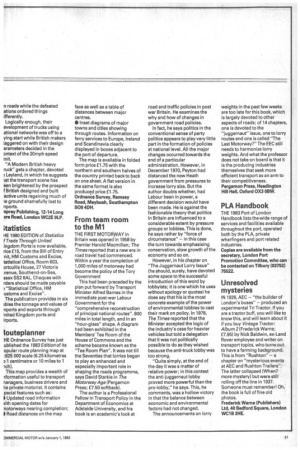From team room to the Ml
Page 53

If you've noticed an error in this article please click here to report it so we can fix it.
THE FIRST MOTORWAY in Britain was opened in 1958 by Premier Harold Macmillan; The Times reported that a new era in road travel had Commenced. Within a year the completion of 1,000 miles of motorway had become the policy of the Tory Government This had been preceded by the plan put forward by Transport Minister Alfred Barnes in the immediate post-war Labour Government for the "comprehensive reconstruction of principal national routes". 800 miles in total length, and in an "hour-glass" shape. A diagram had been exhibited in the Members' Tea Room of the House of Commons and the scheme became known as the "Tea Room Plan". It was not till the Seventies that lorries began to play an enhanced and especially important role in shaping the roads programme, says David Starkie in The Motorway Age (Pergamon Press; E7.50 softback).
The author is a Professional Fellow in Transport Policy in the Department of Economics at Adelaide University, and his book is an academic's look at road and traffic policies in post war Britain. He examines the why and how of changes in government road policies.
In fact, he says politics in the conventional sense of party politics appears to play very little part in the formation of policies at national level. All the major changes occurred towards the end of a particular administration. However, in December 1970, Peyton had distanced the new Heath government from pressures to increase lorry size. But the author doubts whether, had Labour been in power, a different decision would have been made. He is against the fashionable theory that politics in Britain are influenced to a considerable extent by pressure groups or lobbies. This is done, he says rather by "force of circumstance" — in this case the turn towards emphasising conservation, slow growth of the economy and so on.
However, in his chapter on "The Juggernaut Lorry Issue" (he should, surely, have devoted some space to the successful introduction of this word by lobbyists; it is one which he uses without apology or quotes) he does say that his is the most concrete example of the power of environmental lobbies to cast their mark on policy. In 1978, The Times reported that the Minister accepted the logic of the industry's case for heavier vehicles but told a delegation that it was not politically possible to do as they wished because the anti-truck lobby was too strong.
"Quite simply, at the end of the day it was a matter of relative power; in this contest the anti-juggernaut lobby proved more powerful than the pro-lobby," he says. This, he comments, was a hollow victory in that the balance between economic and environmental factors had not changed.
The announcements on lorry weights in the past few weeks are too late for this book, which is largely devoted to other aspects of roads; of 14 chapters, one is devoted to the "juggernaut" issue, one to lorry routes and one is called "The Last Motorway?" The EEC still needs to harmonize lorry weights. And what the professor does not take on board is that it is the producing industries themselves that seek more efficient transport as an arm to their competitiveness. Pergamon Press, Headington Hill Hall, Oxford 0X3 OBW.
















































































